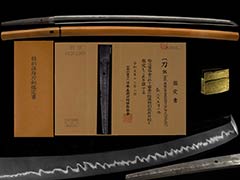
康継 刀Yasutsugu Katana
No.007961刀 葵紋 康継以南蛮鉄於武州江戸作之 身幅3.3cm地刃明るく冴える健全最高傑作 二尺五寸一分Katana Aoimon Yasutsugu Inan NanbanTetsu Oite Busyu Edo-Korewo Tsukuru Mihaba 3.3cm Jiba is bright and clear Kenzen A masterpiece 76.2cm
ご成約Sold
- 銘表Mei-Omote
- 葵紋 康継以南蛮鉄於武州江戸作之葵紋 康継以南蛮鉄於武州江戸作之 Aoimon Yasutsugu Inan NanbanTetsu Oite Busyu Edo Korewo Tsukuru
- 登録証Registration
- 山口県 Yamaguchi 昭和26年3月31日 3/31/26(Showa)
- 時代Period
- 江戸前期寛文頃Early Edo period , Around Kanbun period
- 法量Size
-
刃長 76.2cm (二尺五寸一分) 反り 1.1cm
元幅 3.3cm 先幅 2.2cm 元重 0.74cm 鎬厚 0.74cm 先重 0.59cm 鋒長 3.7cm 茎長 22.5cm 重量 899gHachou 76.2cm (二尺五寸一分) Sori 1.1cm
Moto-Haba 3.3cm Saki-Haba 2.2cm Moto-Kasane 0.74cm Shinogi-Thikess 0.74cm Saki-Kasane 0.59cm Kissaki-Chou 3.7cm Nakago-Chou 22.5cm Weight 899g - 国Country
- 武蔵Musashi
- 姿Shape
- 鎬造、庵棟、身幅広く、反りやや浅く、中鋒やや延びる。Shinogidukuri, Iorimune, Wide Mihaba, Slightly shallow Sori, Chu-Kissaki slightly extended.
- 鍛Kitae
- 板目肌に、小杢目肌交じり、地沸微塵に厚くつき、地景細かくよく入り、肌立ち、鉄冴える。Itamehada, Mixed Small-Mokumehada, Jinie entered fine and thick, Chikei entered finely, Hadatachi, Iron is clear.
- 刃文Hamon
- 互の目に、丁子交じり、足太くよく入り、沸深くよくつき、金筋砂流し細かくかかり、匂深く、匂口明るく冴える。Gunome, Mixed Chouji, Ashi enters thick well, Deep Nie entered well, Kinsuji and Sunagashi entered fine, Deep Nioi, Nioikuchi is bright and clear.
- 帽子Boushi
- 直ぐに小丸、深く返る。Suguni-Komaru, Deep return(Fukaku-Kaeru)
- 茎Nakago
- 生ぶ、先入山形、鑢目勝手下り、目釘孔一。Ubu, SakiiriYamagata, Yasurime-Kattesagari, Mekugiana is one(1)
- ハバキHabaki
- 金着二重。Double gold.
- 説明Drscription
- 越前康継は、徳川将軍家及び越前松平家に抱えられた刀工で、通称葵下坂と呼ばれ、初二代ともに新刀最上作に列する。古上作の写しを得意とし、大名家伝来の正宗、貞宗、信国には康継の作と思われるものが多くあるという。初代康継は、近江国坂田郡下坂郷の出身で、美濃赤坂千手院広長の子と伝え、名を下坂市左衛門と称し、文禄年間に肥後大掾を受領、慶長六年(1601年)に越前入りした結城秀康より四十石の扶持を受けた。初期は越前下坂と銘し、慶長十一年頃に徳川家康及び秀忠により召し出され、鍛刀した際にその技量を認められ、家康の康の一字と葵紋を切ることを許され康継と改め、将軍家御用鍛治となり五十人扶を受ける。以後二代までは、隔年江戸と越前にて打つという。江戸三代康継は、二代康継の嫡子で、名を右馬助という。彼が十七歳の時に父が没し、初代康継の三男である四郎右衛門との間に相続争いが起こったが、江戸を右馬助が、叔父四郎右衛門が越前を相続することで決着し、以後下坂家は江戸と越前に分かれて作刀している。この刀は、二尺五寸一分の長さに身幅3.3cm重量900gに迫り、反りやや浅い、寛文新刀の姿で、地沸微塵に厚くつき、地景細かくよく入り、肌立った美しい地鉄に、互の目に丁子刃交じり、足太く入り、沸深くよくつき、匂深く、匂口明るく冴え、頗る健全な最高傑作である。山口510号の毛利家伝来と思われる名品である。Yasutsugu Echizen is a swordsmith held by the Tokugawa Shogunate and the Echizen Matsudaira family.
Known as Aoi Shimosaka, both the first and second generations are listed in Shinto's best work.He specializes in copying old Jousaku, and many of the Masamune, Sadamune, and Nobukuni, which were introduced by the daimyo family, are believed to have been made by Yasutsugu.
The first Yasutsugu was born in Shimosakagou, Sakata-gun, Ouminokuni, and was said to be a child of Mino Akasaka Senjuin Hitonaga, and his name was Shimosaka Ichizaemon.
He received Higo Daijou during the Bunroku era and received the possession of 40 stones from Yuki Hideyasu, who entered Echizen in the 6th year of Keicho (1601).Initially named Echizen Shimosaka, it was called by Ieyasu Tokugawa and Hidetada around the 11th year of Keicho.
He was recognized for his skill when he forged a sword, and was allowed to cut Ieyasu's character and "Aoimon".He becomes a blacksmith for the shogunate and he receives fifty men.After that, until the second generation, it is said that he will hit in Edo and Echizen every other year. Yasutsugu Edo III is the firstborn of Yasutsugu II, and his name is Umasuke.His father died when he was seventeen years old, and an inheritance dispute arose with Shirouuemon, the third son of the first Yasutsugu. Since then, the Shimosaka family has divided into Edo and Echizen to make swords.
This sword is approximately weighs 900g, 76.2xmm Mihaba3.3cm, and slightly shallow Sori, In the form of Kanbun Shinto, Jinie entered fine and thick, Chikei entered fine well, Hadatatta-Beautiful Jitetsu, Gunome and Mixed Choujiba, Ashi entered thick, Deep Nie entered well, Deep Nioi, Nioikuchi is bright and clear. It extremely Kenzen A masterpiece. Yamaguchi No. 510 that is thought to have been handed down to the Mori family.


